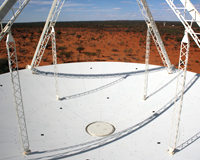Now available: 3TB of ASKAP data for public discovery
5 November 2015
A select amount of demonstration project data from the Boolardy Engineering Test Array (BETA) has today been released by the CSIRO ASKAP Data Science Archive (CASDA) team, a vital step in preparation for the start of ASKAP Early Science in 2016.
The CASDA project aims to deliver the ASKAP science archive, with access provided to general users. TodayâÀÙs initial production release will provide tools and user services to all users, along with approximately 3 TB of ASKAP commissioning data products.
This release, coupled with a second production release in early 2016, will provide the archive services necessary for the start of Early Science.
CASDA is one of three subsystems, with the Telescope Operating System (TOS) and the Central Processor, which form the core component of ASKAP computing. CASDA is the primary point for storing, managing and sharing fully calibrated and science-ready data products. It will also provide the ASKAP Survey Science Teams with access to processed data products for analysis.
The CASDA development team includes individuals from CSIRO Astronomy and Space Science (CASS) and CSIRO Information Management and Technology (IM&T), along with staff from the Pawsey Supercomputing Centre.
Since the CASDA project began, the team has been working on confirming system requirements, as well as designing and verifying the proposed system architecture. The challenges associated with the large amount of data that will be produced by ASKAP means the team has had to consider how to build a data archive system that will be able to manage as well as store this data.
âÀÜCASDA currently archives some data products produced from the BETA âÀØdemonstration projectsâÀÙ that have already produced some exciting, and published, initial science results,âÀÝ explains Jessica Chapman, CASDA Project Leader, âÀÜTodayâÀÙs initial production release will make available these data products, and we will continue to work with the ASKAP commissioning team to automate and streamline the ingest of data products as we progress towards Early Science.âÀÝ
Once the full ASKAP telescope is commissioned, data is expected to arrive for processing at the Pawsey Supercomputing Centre in Perth at rates of around 2.5 Gbps, equivalent to 75 Petabytes per year. Such large volumes will require ASKAP data processing to be carried out in quasi-real time using automated pipelines to produce data products and associated metadata that are stored and made available through the science archive.
CASDA will provide the long term storage for ASKAP data products, as well as the hardware and software facilities that enable astronomers to make use of these âÀÓ with the total volume of archive data is expected to reach 5 PB per year.
Data collections from the major ASKAP surveys will be openly available to the global astronomy community following a process of data validation, and it is anticipated that the data archive will be used by at least 1500 astronomers for various science research projects.
âÇÒTo get started with CASDA: see the CASDA Users Guide. For all enquiries and assistance, please email ATNF Data Support.
ƒŠ
Back to Latest ASKAP News page.

